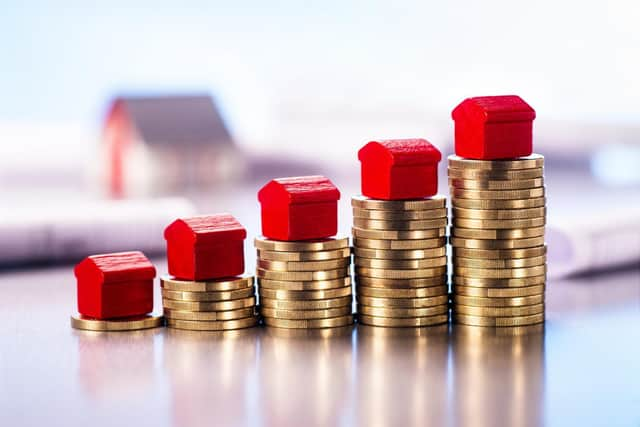Here’s how your area’s average house price has performed this year and over the last 10 years
An exclusive report for The Yorkshire Post by Savills reveals how Yorkshire house prices have fared this year and over the last 10 years. The region’s average residential property price a decade ago was £132,380 and is now £185,968, revealing a 40.5 per cent growth.
The study based on Land Registry details the rises in all local authority areas between 2011 and 2021 and shows some interesting results. Richmondshire, which includes Wensleydale, Swaledale, Coverdale and Arkengarthdale, was the top performer over the 12 months from August 2020 to August 2021, with a 20.6 per cent rise in house prices, due in large part to the escape to the country prompted by the pandemic. The average house price there is now £259,310.
Advertisement
Hide AdAdvertisement
Hide AdRyedale, which includes Malton, Helmsley and Pickering, along with a host of pretty villages, saw the second highest growth over the year with a 17.7 per cent rise bringing its average price to £282,232. Rotherham recorded the third highest increase after seeing annual values rocket by 16.1 per cent pushing the average house price to £167,293 and Wakefield and


Barnsley were not far behind with 15.5 per cent and 15.2 per cent respectively bringing their average home price to £178,468 and £149,055. The increasing popularity of these west and south Yorkshire areas is, in part, due to buyers extending their boundaries to find value for money and good transport links. Meanwhile, property hotspots Craven and Harrogate districts saw some of the lowest gains over the year with 7 per cent and 5.6 per cent respectively bringing their average value to £305,685 and £245,659.
Harrogate is the most expensive place to buy a home followed by York where the average value is £284,750. The most affordable place is Hull, where the average price is £121,300.
Analysis of house price gains over the last 10 years tells a different story with the cities at the top of the growth table. Leeds led with a 54.6 per cent rise, followed by York with 54 per cent and Sheffield with 52.7 per cent.
Advertisement
Hide AdAdvertisement
Hide AdThe areas that showed the lowest house price growth in the last decade were desirable Hambleton, which includes Thirsk and Easingwold, with 29.8 per cent and Scarborough district, which includes Whitby and Filey, with 28 per cent and Bradford with 30.3 per cent. Meanwhile the latest ONS report on house prices, which covers September 2021, reveals that while there was a 12 per cent year-on-year average rise in Yorkshire, momentum is slowing.
Estate agent Ben Pridden of Hewetson and Johnson says: “There is little doubt things are calming down from the frenetic market we have experienced for most of 2021. The prospect of interest rate rises and inflationary pressure on households, combined with the ending of a significant saving on stamp duty is exerting downward pressure on the market. “However, very few pundits are suggesting values will fall next year and we believe that moderate growth seems likely.
“The prime market, where there is a higher proportion of cash funded purchases, is likely to outperform the mainstream properties which are more sensitive to the cost of borrowing.”
Ben has words of caution to over-ambitious sellers: “The key to a functioning property market is pricing. We have concerns that owners will be tempted to push the limits too far when pricing their homes in the new year, which in the past has resulted in a stagnant market.”
Advertisement
Hide AdAdvertisement
Hide AdFor those planning to sell top end homes, he suggests marketing them sooner rather than later.
Here is the data from Savills on house price rises this year and over the last 10 years, between August 2011 and 2021, in all of the Yorkshire districts. The first figures show the 2021 rise and the average value while the second is the increase over the last 10 years.
Richmondshire 20.6 per cent (£259,310), 42.6 per cent (£181,150); Ryedale 17.7 per cent (£282,232), 50.8 per cent (£187,201); Rotherham 16.1 per cent (£167,293), 43.5 per cent (£116,614); Wakefield 15.5 per cent (£178,468), 44.6 per cent (£123,420); Barnsley 15.2 per cent (£149,055), 43.6 per cent (£103,808); Selby 13.4 per cent (£237,041), 50.9 per cent (£157,107); Sheffield 12.7 per cent (£192,236), 52.7 per cent (£125,926); East Riding 11.7 per cent (£204,773), 41.9 per cent (£125,926); Hambleton 11.5 per cent (£260,741), 29.8 per cent (£200,941); York 11.3 per cent (£284,750), 54 per cent (£184,930); Scarborough 11 per cent (£190,203), 28 per cent (£148,552); Leeds 10.6 per cent (£216,580), 54.6 per cent (£140,126); Doncaster, 10.2 per cent ( £148,851), 34.9 per cent (£110,351); Calderdale 10 per cent (£166,544), 39.5 per cent (£119,414); Kirklees 8.3 per cent (£170,637); 38.2 per cent (£123, 458); Harrogate, 7 per cent (£305,685), 35.7 per cent (£225,326); Bradford 7 per cent (£156,076), 30.3 per cent (£119,796) Hull 5.9 per cent (£121,300), 38.4 per cent (£87,667); Craven 5.6 per cent (£245,659), 35.7 per cent (£180,966).
Please support The Yorkshire Post and become a subscriber today. Your subscription will help us to continue to bring quality news to the people of Yorkshire. In return, you'll see fewer ads on site, get free access to our app and receive exclusive members-only offers. Click here to subscribe